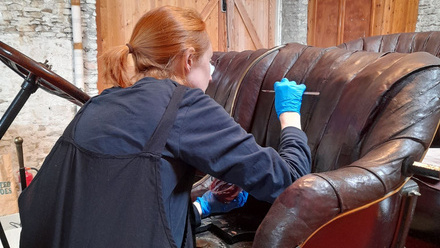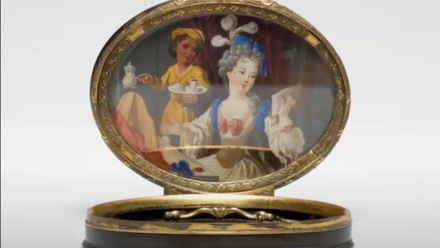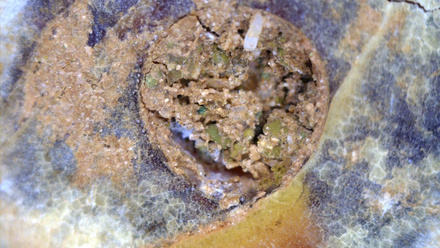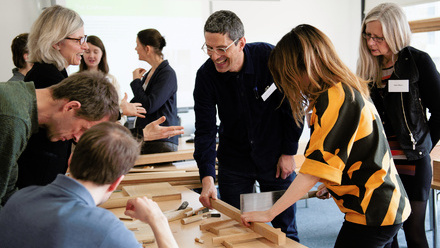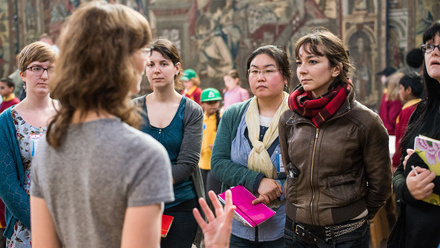Responding to the news about the damaging work to a copy of a famous painting of the immaculate conception by the baroque artist Bartolomé Esteban Murillo, Acre (the Spanish equivalent of Icon) said: "The lack of regulation translates into absence of protection of our heritage."
Acre’s frustration is palpable and understandable, as they have raised the issue of regulation and protection of cultural heritage on two previous occasions, namely the well-meaning but damaging attempt to restore a fresco in the Sanctuary of Mercy Church in Borja by elderly parishioner Cecilia Gimenez in 2012, and the restoration attempt by a local arts and crafts teacher of a 16th Century wooden polychrome sculpture of St George in the Romanesque Church of San Miguel de Estella in Navarre, which generated much amusement on social media.
The latest case differs slightly. The painting in question was from a private collection and the work was commissioned from a local furniture restorer for the princely sum of €1,200 (£1,087). In this case the intervention and failure of a professional to act within their knowledge and competence ought to give the owner recourse, but is likely to involve the civil courts, which will no doubt be a long and costly process.
The BBC reported that there is: “no law in Spain forbidding people from restoring, even if they do so without the necessary skills.”
This is not surprising given than the work that conservators undertake doesn’t have a public safety element; conservators’ decisions and interventions do not have an impact on people’s lives in the same way as doctors or dentists. And the conservator’s role isn’t linked to compliance with high level legislation and regulations as you find with, for example, structural engineers or accountants. So, we have no such regulation in the UK either.
Carrots or sticks?
Given the current political and economic situation, there may be little political appetite for introducing new forms of regulation at a national level. However, legislation may not be the answer anyway as it is often a blunt and expensive tool that is generally deployed retrospectively. There is thus a strong case for supporting a regulated conservation profession, maintained through the mechanism of a professional body with appropriate accreditation processes based on individual competence.
Icon fulfils the role of self-regulation of the conservation profession in the UK though formal accreditation and the use of a mandatory Code of Conduct. There is also a general reverence and respect for cultural heritage and an understanding of the value of expertise amongst members of the public. We may conclude that these are some of the reasons why we do not see similar high-profile examples of poor decision making about conservation treatments, carried out by either well-meaning individuals or so-called professionals.
But Icon’s purpose if not just to act as the professional body for its members. As a charity Icon also has a mission to provide advice and support for clients and those who might want to commission conservation work. The newly revamped Conservation Register guides anyone with a conservation issue to a number of qualified and competent practitioners covering a large range of specialisms. Using an accredited conservator provides a valuable guarantee that the professional will be appropriately qualified. More importantly, clients can feel confident that the practitioner will work within the limits of the knowledge and expertise as set out in Icon’s Code of Conduct. If the client is unhappy with the work or the service they have received then there is also recourse through Icon’s robust complaints procedure. This combination makes for a high level of effective self-regulation within the conservation profession in the UK.
Being a good client
However, there is also a level of responsibility that falls on people who own cultural heritage objects, which in many ways belong to us all as they are part of our shared cultural inheritance. Icon strongly encourages clients to accept the responsibility to undertake due diligence when selecting a practitioner to undertake conservation or restoration work. Using the Conservation Register is an excellent first port of call but clients are also advised to follow up references and find out about past projects before accepting a conservator’s services. It is also worthwhile to do some background reading to help understand the difference between conservation and restoration.
Icon accepts that as a profession we have a shared responsibility to help clients make good choices. To address this there is a wealth of information and advice on the Icon website including "Caring for" Guides.
Calls for increased levels of regulation for the protection of cultural heritage are not new, but there is a danger that practitioners and their organisations see the primary duty of regulation as a way to protect their professional interests when actually the interests of those responsible for the cultural heritage, be they private or public, should be at the heart of any (self) regulation processes.
Icon is, in my opinion, one of the world’s outstanding organisations in the realm of accreditation and self-regulation, operating rigorous processes and striving at all times to uphold and champion the highest professional standards and behavior. It takes this role very seriously and continues to improve its approach to self-regulation through consensus. My only wish is that their role might receive more recognition and support from Government. Perhaps if we shared some of our own headlines about ‘botched’ work then we would see more interest in this issue from those in power.
---
Image: Creative Commons

